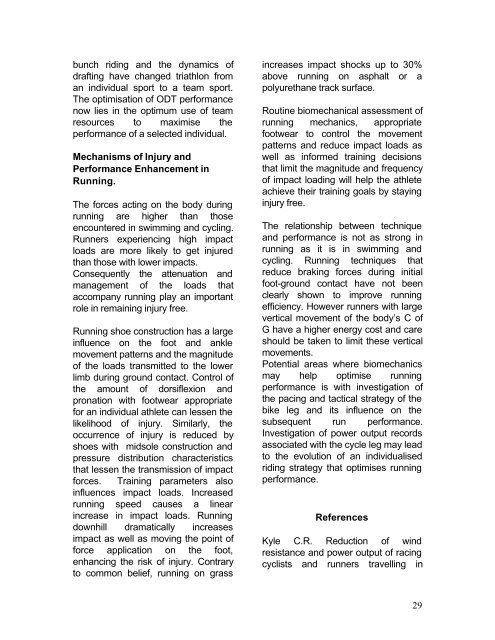MAXIMISING OLYMPIC DISTANCE TRIATHLON PERFORMANCE ...
MAXIMISING OLYMPIC DISTANCE TRIATHLON PERFORMANCE ...
MAXIMISING OLYMPIC DISTANCE TRIATHLON PERFORMANCE ...
Create successful ePaper yourself
Turn your PDF publications into a flip-book with our unique Google optimized e-Paper software.
unch riding and the dynamics ofdrafting have changed triathlon froman individual sport to a team sport.The optimisation of ODT performancenow lies in the optimum use of teamresources to maximise theperformance of a selected individual.Mechanisms of Injury andPerformance Enhancement inRunning.The forces acting on the body duringrunning are higher than thoseencountered in swimming and cycling.Runners experiencing high impactloads are more likely to get injuredthan those with lower impacts.Consequently the attenuation andmanagement of the loads thataccompany running play an importantrole in remaining injury free.Running shoe construction has a largeinfluence on the foot and anklemovement patterns and the magnitudeof the loads transmitted to the lowerlimb during ground contact. Control ofthe amount of dorsiflexion andpronation with footwear appropriatefor an individual athlete can lessen thelikelihood of injury. Similarly, theoccurrence of injury is reduced byshoes with midsole construction andpressure distribution characteristicsthat lessen the transmission of impactforces. Training parameters alsoinfluences impact loads. Increasedrunning speed causes a linearincrease in impact loads. Runningdownhill dramatically increasesimpact as well as moving the point offorce application on the foot,enhancing the risk of injury. Contraryto common belief, running on grassincreases impact shocks up to 30%above running on asphalt or apolyurethane track surface.Routine biomechanical assessment ofrunning mechanics, appropriatefootwear to control the movementpatterns and reduce impact loads aswell as informed training decisionsthat limit the magnitude and frequencyof impact loading will help the athleteachieve their training goals by stayinginjury free.The relationship between techniqueand performance is not as strong inrunning as it is in swimming andcycling. Running techniques thatreduce braking forces during initialfoot-ground contact have not beenclearly shown to improve runningefficiency. However runners with largevertical movement of the body’s C ofG have a higher energy cost and careshould be taken to limit these verticalmovements.Potential areas where biomechanicsmay help optimise runningperformance is with investigation ofthe pacing and tactical strategy of thebike leg and its influence on thesubsequent run performance.Investigation of power output recordsassociated with the cycle leg may leadto the evolution of an individualisedriding strategy that optimises runningperformance.ReferencesKyle C.R. Reduction of windresistance and power output of racingcyclists and runners travelling in29


